Managing Across Borders (HI5013) Tutorial Questions Assignment 1
VerifiedAdded on 2023/01/11
|8
|2478
|28
Homework Assignment
AI Summary
This assignment solution addresses tutorial questions related to managing across borders, focusing on key concepts such as internationalization, means of transportation, and the essential characteristics of international managers. It explores various methods of internationalization including export-based and non-equity based methods like franchising and licensing. The assignment also analyzes the criticisms faced by multinational enterprises (MNEs) regarding their 'cash-cow' approach and discusses the four important culture-based norms and beliefs including folkways, taboos, mores, and laws. Furthermore, it delves into the fundamental patterns of cultural differences in communication styles, task approaches, conflict attitudes, decision-making, and disclosure. This comprehensive document offers a detailed examination of the complexities involved in managing businesses across international borders.
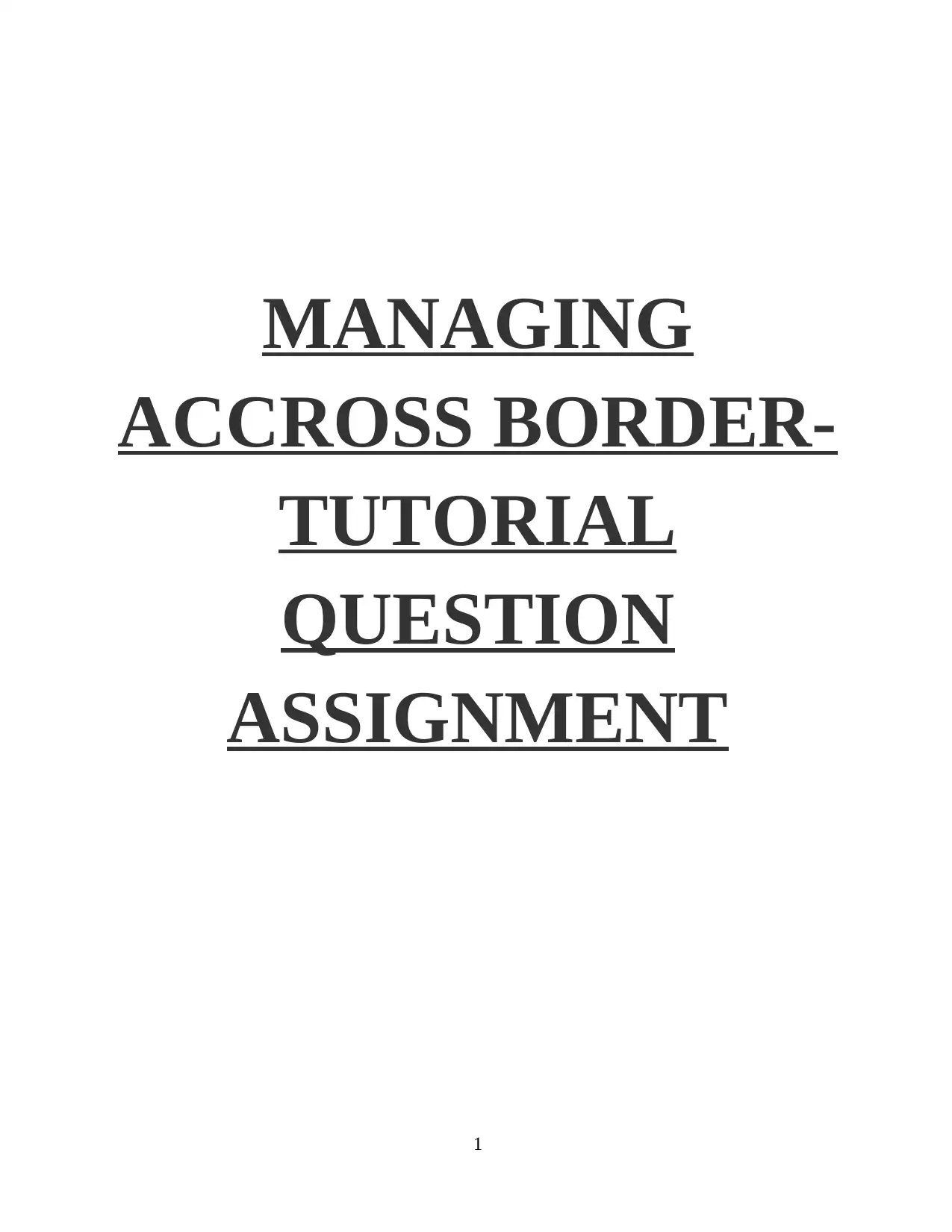
MANAGING
ACCROSS BORDER-
TUTORIAL
QUESTION
ASSIGNMENT
1
ACCROSS BORDER-
TUTORIAL
QUESTION
ASSIGNMENT
1
Paraphrase This Document
Need a fresh take? Get an instant paraphrase of this document with our AI Paraphraser
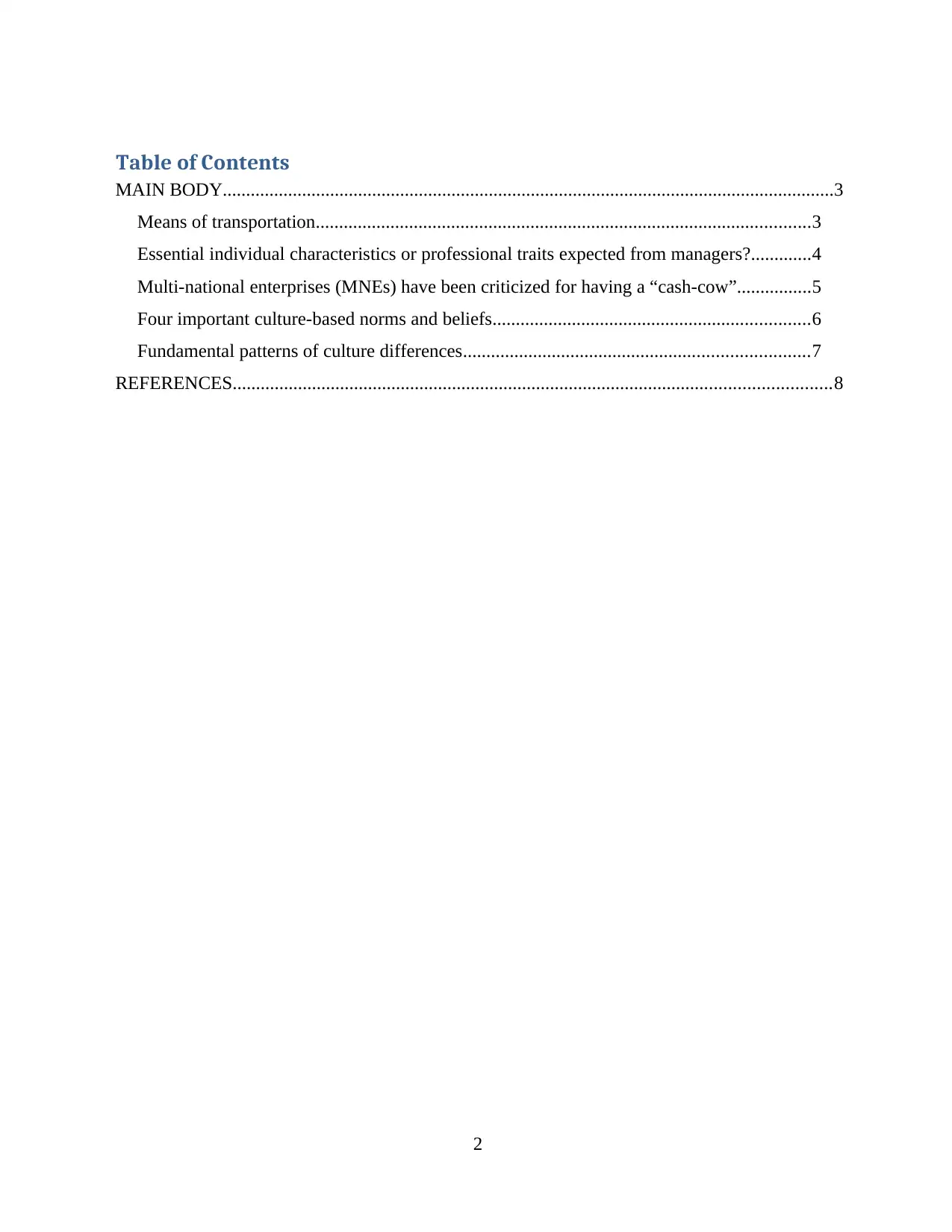
Table of Contents
MAIN BODY...................................................................................................................................3
Means of transportation..........................................................................................................3
Essential individual characteristics or professional traits expected from managers?.............4
Multi-national enterprises (MNEs) have been criticized for having a “cash-cow”................5
Four important culture-based norms and beliefs....................................................................6
Fundamental patterns of culture differences..........................................................................7
REFERENCES................................................................................................................................8
2
MAIN BODY...................................................................................................................................3
Means of transportation..........................................................................................................3
Essential individual characteristics or professional traits expected from managers?.............4
Multi-national enterprises (MNEs) have been criticized for having a “cash-cow”................5
Four important culture-based norms and beliefs....................................................................6
Fundamental patterns of culture differences..........................................................................7
REFERENCES................................................................................................................................8
2
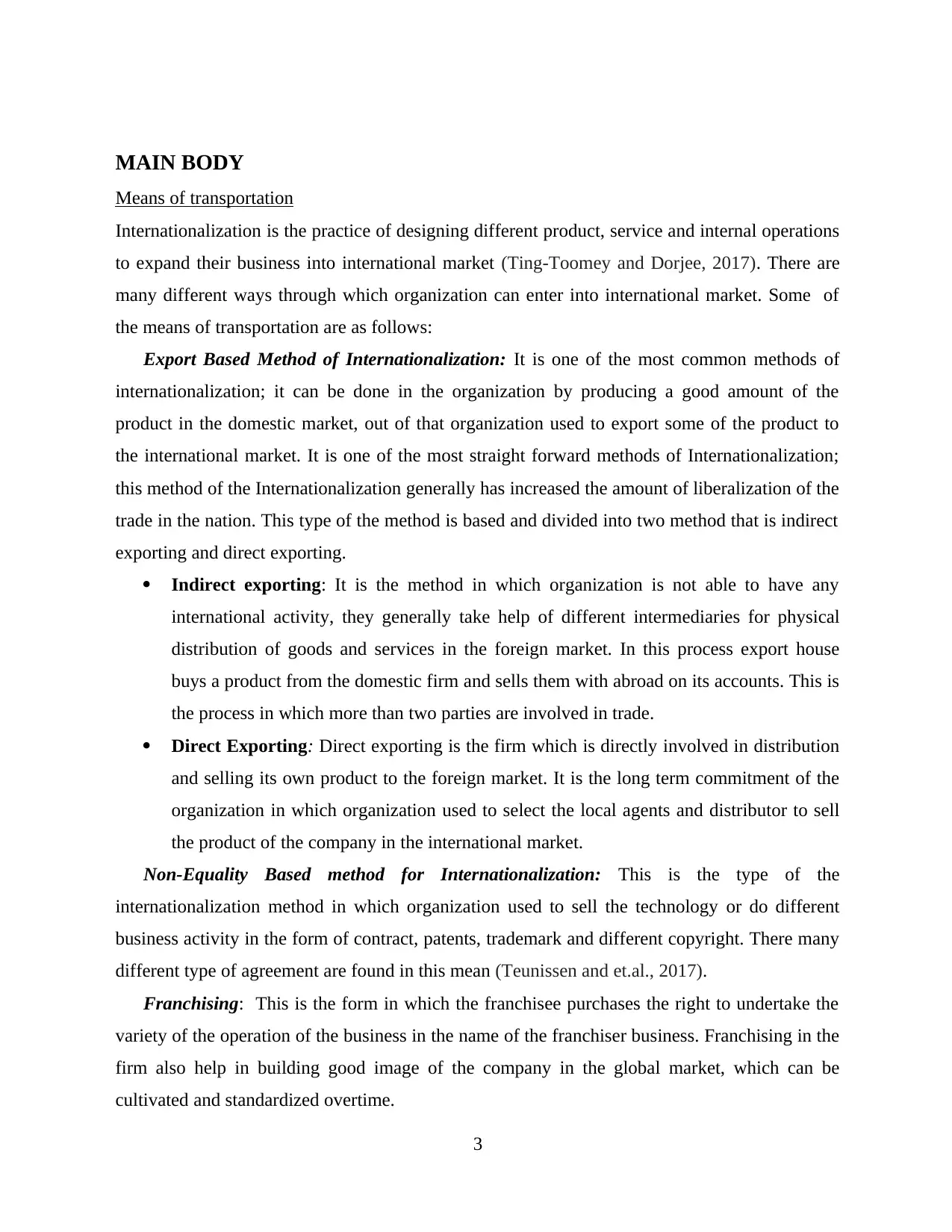
MAIN BODY
Means of transportation
Internationalization is the practice of designing different product, service and internal operations
to expand their business into international market (Ting-Toomey and Dorjee, 2017). There are
many different ways through which organization can enter into international market. Some of
the means of transportation are as follows:
Export Based Method of Internationalization: It is one of the most common methods of
internationalization; it can be done in the organization by producing a good amount of the
product in the domestic market, out of that organization used to export some of the product to
the international market. It is one of the most straight forward methods of Internationalization;
this method of the Internationalization generally has increased the amount of liberalization of the
trade in the nation. This type of the method is based and divided into two method that is indirect
exporting and direct exporting.
Indirect exporting: It is the method in which organization is not able to have any
international activity, they generally take help of different intermediaries for physical
distribution of goods and services in the foreign market. In this process export house
buys a product from the domestic firm and sells them with abroad on its accounts. This is
the process in which more than two parties are involved in trade.
Direct Exporting: Direct exporting is the firm which is directly involved in distribution
and selling its own product to the foreign market. It is the long term commitment of the
organization in which organization used to select the local agents and distributor to sell
the product of the company in the international market.
Non-Equality Based method for Internationalization: This is the type of the
internationalization method in which organization used to sell the technology or do different
business activity in the form of contract, patents, trademark and different copyright. There many
different type of agreement are found in this mean (Teunissen and et.al., 2017).
Franchising: This is the form in which the franchisee purchases the right to undertake the
variety of the operation of the business in the name of the franchiser business. Franchising in the
firm also help in building good image of the company in the global market, which can be
cultivated and standardized overtime.
3
Means of transportation
Internationalization is the practice of designing different product, service and internal operations
to expand their business into international market (Ting-Toomey and Dorjee, 2017). There are
many different ways through which organization can enter into international market. Some of
the means of transportation are as follows:
Export Based Method of Internationalization: It is one of the most common methods of
internationalization; it can be done in the organization by producing a good amount of the
product in the domestic market, out of that organization used to export some of the product to
the international market. It is one of the most straight forward methods of Internationalization;
this method of the Internationalization generally has increased the amount of liberalization of the
trade in the nation. This type of the method is based and divided into two method that is indirect
exporting and direct exporting.
Indirect exporting: It is the method in which organization is not able to have any
international activity, they generally take help of different intermediaries for physical
distribution of goods and services in the foreign market. In this process export house
buys a product from the domestic firm and sells them with abroad on its accounts. This is
the process in which more than two parties are involved in trade.
Direct Exporting: Direct exporting is the firm which is directly involved in distribution
and selling its own product to the foreign market. It is the long term commitment of the
organization in which organization used to select the local agents and distributor to sell
the product of the company in the international market.
Non-Equality Based method for Internationalization: This is the type of the
internationalization method in which organization used to sell the technology or do different
business activity in the form of contract, patents, trademark and different copyright. There many
different type of agreement are found in this mean (Teunissen and et.al., 2017).
Franchising: This is the form in which the franchisee purchases the right to undertake the
variety of the operation of the business in the name of the franchiser business. Franchising in the
firm also help in building good image of the company in the global market, which can be
cultivated and standardized overtime.
3
⊘ This is a preview!⊘
Do you want full access?
Subscribe today to unlock all pages.

Trusted by 1+ million students worldwide
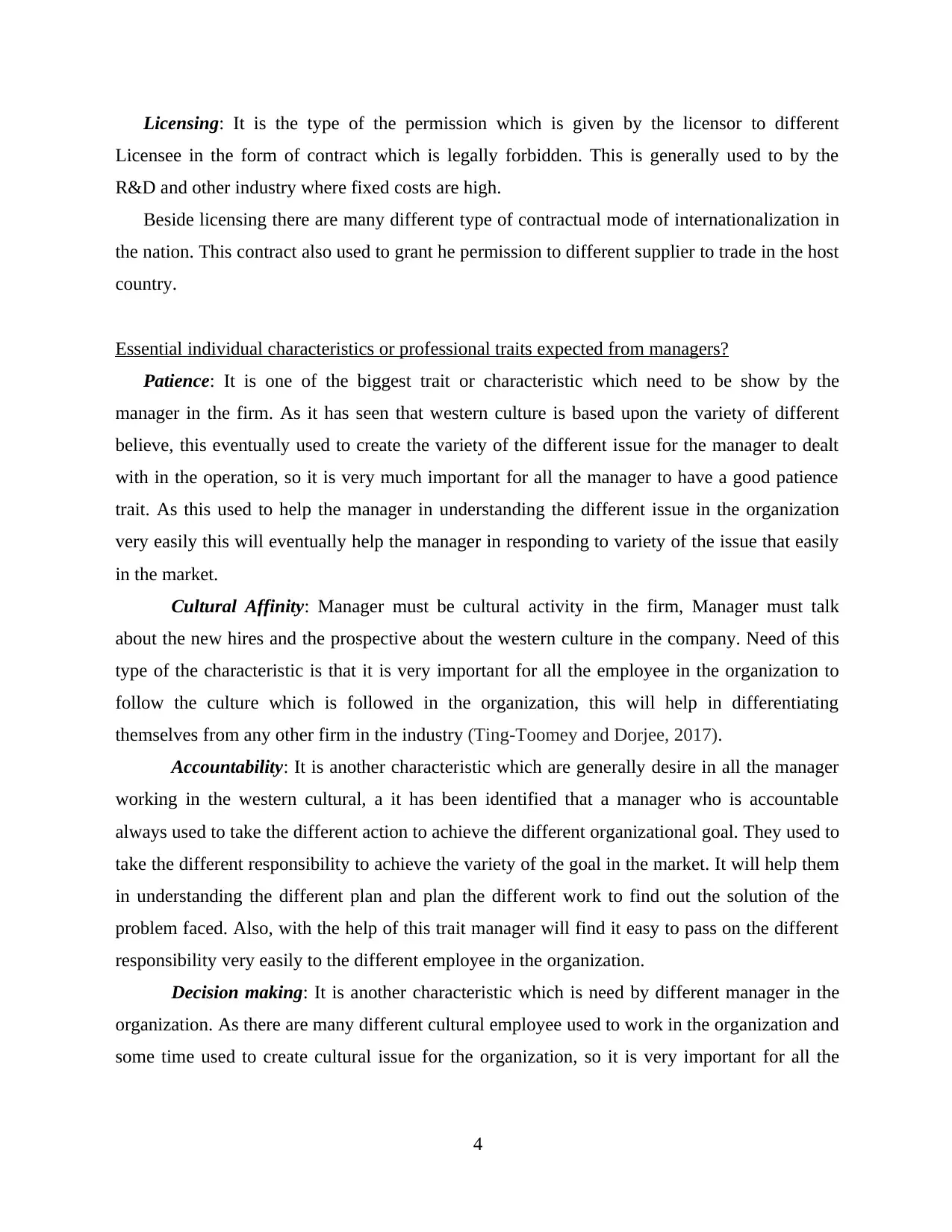
Licensing: It is the type of the permission which is given by the licensor to different
Licensee in the form of contract which is legally forbidden. This is generally used to by the
R&D and other industry where fixed costs are high.
Beside licensing there are many different type of contractual mode of internationalization in
the nation. This contract also used to grant he permission to different supplier to trade in the host
country.
Essential individual characteristics or professional traits expected from managers?
Patience: It is one of the biggest trait or characteristic which need to be show by the
manager in the firm. As it has seen that western culture is based upon the variety of different
believe, this eventually used to create the variety of the different issue for the manager to dealt
with in the operation, so it is very much important for all the manager to have a good patience
trait. As this used to help the manager in understanding the different issue in the organization
very easily this will eventually help the manager in responding to variety of the issue that easily
in the market.
Cultural Affinity: Manager must be cultural activity in the firm, Manager must talk
about the new hires and the prospective about the western culture in the company. Need of this
type of the characteristic is that it is very important for all the employee in the organization to
follow the culture which is followed in the organization, this will help in differentiating
themselves from any other firm in the industry (Ting-Toomey and Dorjee, 2017).
Accountability: It is another characteristic which are generally desire in all the manager
working in the western cultural, a it has been identified that a manager who is accountable
always used to take the different action to achieve the different organizational goal. They used to
take the different responsibility to achieve the variety of the goal in the market. It will help them
in understanding the different plan and plan the different work to find out the solution of the
problem faced. Also, with the help of this trait manager will find it easy to pass on the different
responsibility very easily to the different employee in the organization.
Decision making: It is another characteristic which is need by different manager in the
organization. As there are many different cultural employee used to work in the organization and
some time used to create cultural issue for the organization, so it is very important for all the
4
Licensee in the form of contract which is legally forbidden. This is generally used to by the
R&D and other industry where fixed costs are high.
Beside licensing there are many different type of contractual mode of internationalization in
the nation. This contract also used to grant he permission to different supplier to trade in the host
country.
Essential individual characteristics or professional traits expected from managers?
Patience: It is one of the biggest trait or characteristic which need to be show by the
manager in the firm. As it has seen that western culture is based upon the variety of different
believe, this eventually used to create the variety of the different issue for the manager to dealt
with in the operation, so it is very much important for all the manager to have a good patience
trait. As this used to help the manager in understanding the different issue in the organization
very easily this will eventually help the manager in responding to variety of the issue that easily
in the market.
Cultural Affinity: Manager must be cultural activity in the firm, Manager must talk
about the new hires and the prospective about the western culture in the company. Need of this
type of the characteristic is that it is very important for all the employee in the organization to
follow the culture which is followed in the organization, this will help in differentiating
themselves from any other firm in the industry (Ting-Toomey and Dorjee, 2017).
Accountability: It is another characteristic which are generally desire in all the manager
working in the western cultural, a it has been identified that a manager who is accountable
always used to take the different action to achieve the different organizational goal. They used to
take the different responsibility to achieve the variety of the goal in the market. It will help them
in understanding the different plan and plan the different work to find out the solution of the
problem faced. Also, with the help of this trait manager will find it easy to pass on the different
responsibility very easily to the different employee in the organization.
Decision making: It is another characteristic which is need by different manager in the
organization. As there are many different cultural employee used to work in the organization and
some time used to create cultural issue for the organization, so it is very important for all the
4
Paraphrase This Document
Need a fresh take? Get an instant paraphrase of this document with our AI Paraphraser
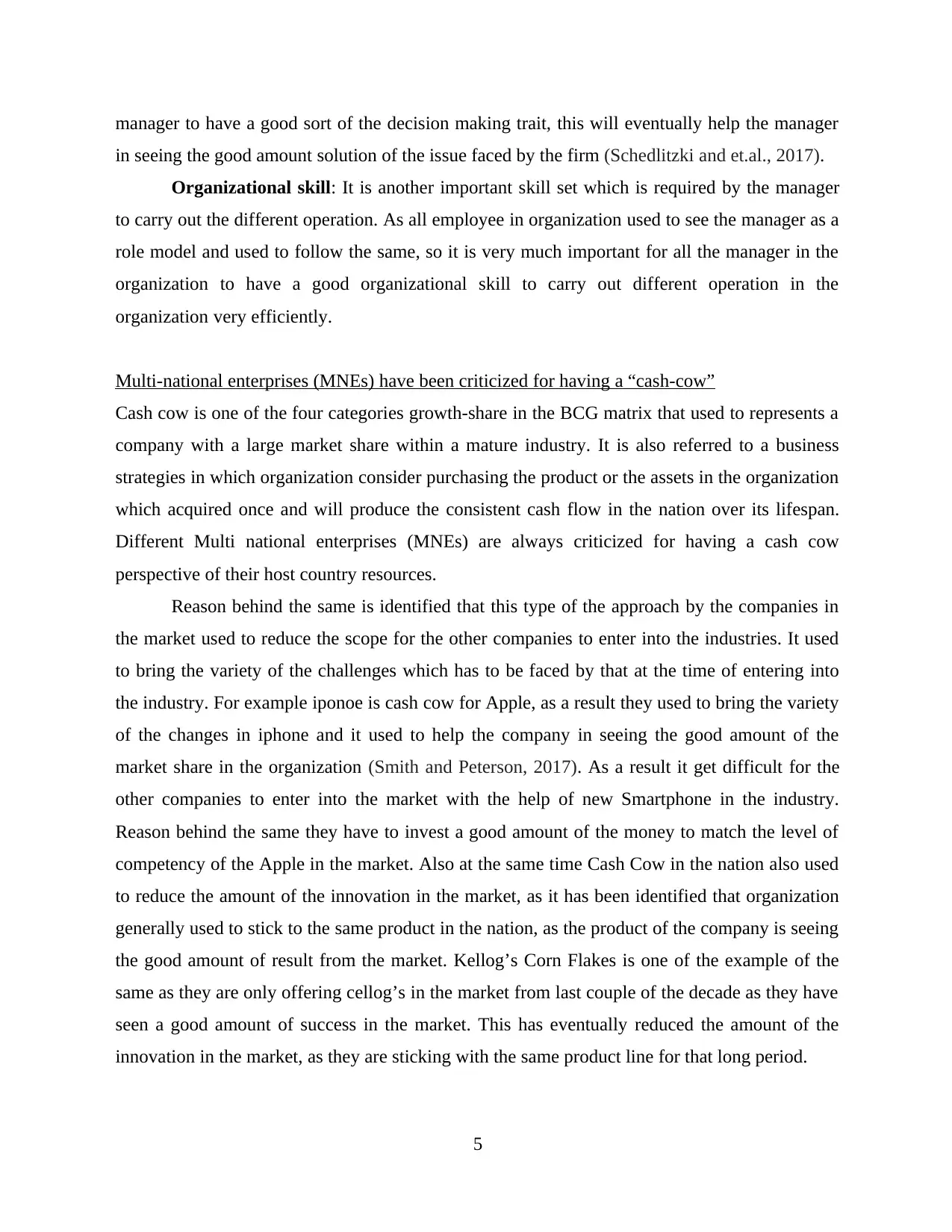
manager to have a good sort of the decision making trait, this will eventually help the manager
in seeing the good amount solution of the issue faced by the firm (Schedlitzki and et.al., 2017).
Organizational skill: It is another important skill set which is required by the manager
to carry out the different operation. As all employee in organization used to see the manager as a
role model and used to follow the same, so it is very much important for all the manager in the
organization to have a good organizational skill to carry out different operation in the
organization very efficiently.
Multi-national enterprises (MNEs) have been criticized for having a “cash-cow”
Cash cow is one of the four categories growth-share in the BCG matrix that used to represents a
company with a large market share within a mature industry. It is also referred to a business
strategies in which organization consider purchasing the product or the assets in the organization
which acquired once and will produce the consistent cash flow in the nation over its lifespan.
Different Multi national enterprises (MNEs) are always criticized for having a cash cow
perspective of their host country resources.
Reason behind the same is identified that this type of the approach by the companies in
the market used to reduce the scope for the other companies to enter into the industries. It used
to bring the variety of the challenges which has to be faced by that at the time of entering into
the industry. For example iponoe is cash cow for Apple, as a result they used to bring the variety
of the changes in iphone and it used to help the company in seeing the good amount of the
market share in the organization (Smith and Peterson, 2017). As a result it get difficult for the
other companies to enter into the market with the help of new Smartphone in the industry.
Reason behind the same they have to invest a good amount of the money to match the level of
competency of the Apple in the market. Also at the same time Cash Cow in the nation also used
to reduce the amount of the innovation in the market, as it has been identified that organization
generally used to stick to the same product in the nation, as the product of the company is seeing
the good amount of result from the market. Kellog’s Corn Flakes is one of the example of the
same as they are only offering cellog’s in the market from last couple of the decade as they have
seen a good amount of success in the market. This has eventually reduced the amount of the
innovation in the market, as they are sticking with the same product line for that long period.
5
in seeing the good amount solution of the issue faced by the firm (Schedlitzki and et.al., 2017).
Organizational skill: It is another important skill set which is required by the manager
to carry out the different operation. As all employee in organization used to see the manager as a
role model and used to follow the same, so it is very much important for all the manager in the
organization to have a good organizational skill to carry out different operation in the
organization very efficiently.
Multi-national enterprises (MNEs) have been criticized for having a “cash-cow”
Cash cow is one of the four categories growth-share in the BCG matrix that used to represents a
company with a large market share within a mature industry. It is also referred to a business
strategies in which organization consider purchasing the product or the assets in the organization
which acquired once and will produce the consistent cash flow in the nation over its lifespan.
Different Multi national enterprises (MNEs) are always criticized for having a cash cow
perspective of their host country resources.
Reason behind the same is identified that this type of the approach by the companies in
the market used to reduce the scope for the other companies to enter into the industries. It used
to bring the variety of the challenges which has to be faced by that at the time of entering into
the industry. For example iponoe is cash cow for Apple, as a result they used to bring the variety
of the changes in iphone and it used to help the company in seeing the good amount of the
market share in the organization (Smith and Peterson, 2017). As a result it get difficult for the
other companies to enter into the market with the help of new Smartphone in the industry.
Reason behind the same they have to invest a good amount of the money to match the level of
competency of the Apple in the market. Also at the same time Cash Cow in the nation also used
to reduce the amount of the innovation in the market, as it has been identified that organization
generally used to stick to the same product in the nation, as the product of the company is seeing
the good amount of result from the market. Kellog’s Corn Flakes is one of the example of the
same as they are only offering cellog’s in the market from last couple of the decade as they have
seen a good amount of success in the market. This has eventually reduced the amount of the
innovation in the market, as they are sticking with the same product line for that long period.
5
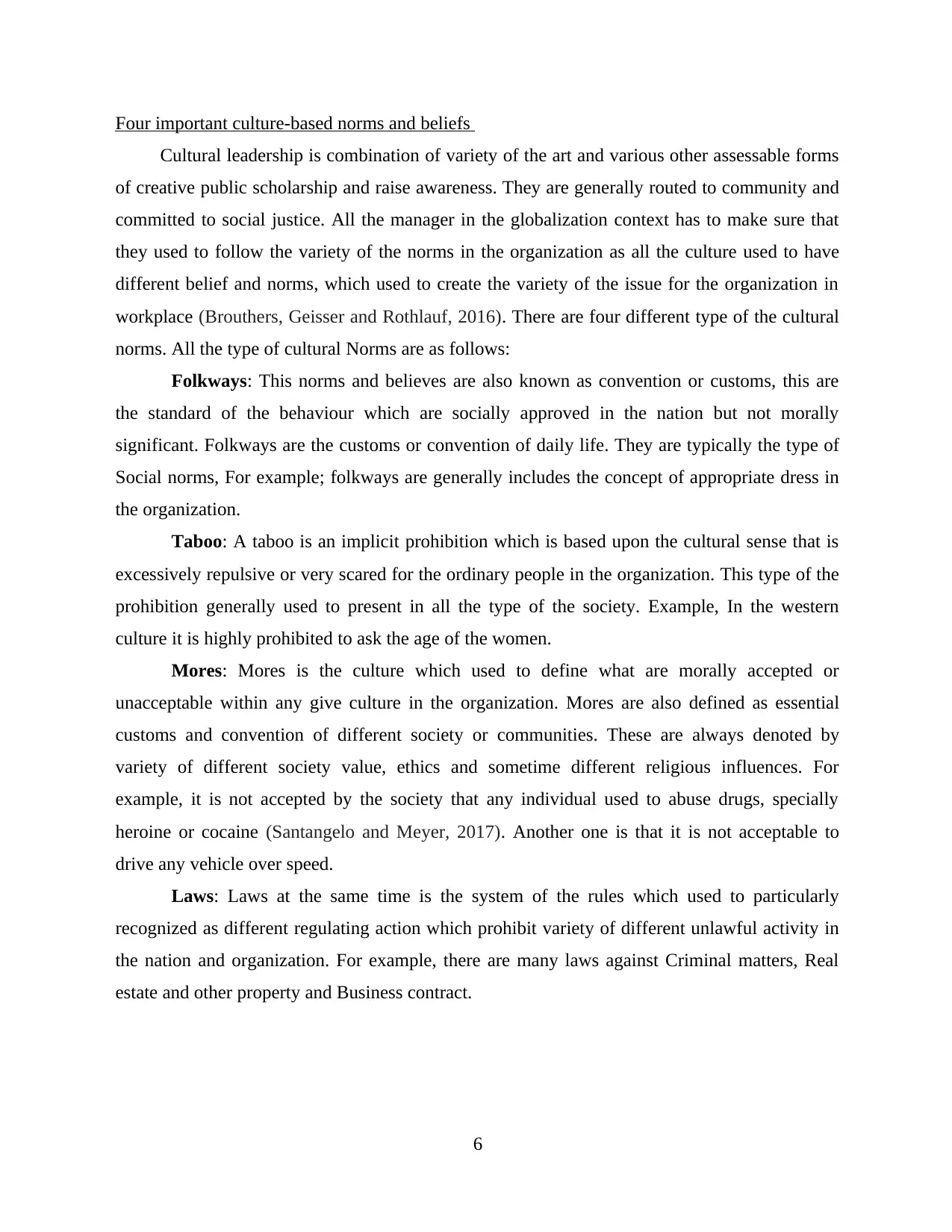
Four important culture-based norms and beliefs
Cultural leadership is combination of variety of the art and various other assessable forms
of creative public scholarship and raise awareness. They are generally routed to community and
committed to social justice. All the manager in the globalization context has to make sure that
they used to follow the variety of the norms in the organization as all the culture used to have
different belief and norms, which used to create the variety of the issue for the organization in
workplace (Brouthers, Geisser and Rothlauf, 2016). There are four different type of the cultural
norms. All the type of cultural Norms are as follows:
Folkways: This norms and believes are also known as convention or customs, this are
the standard of the behaviour which are socially approved in the nation but not morally
significant. Folkways are the customs or convention of daily life. They are typically the type of
Social norms, For example; folkways are generally includes the concept of appropriate dress in
the organization.
Taboo: A taboo is an implicit prohibition which is based upon the cultural sense that is
excessively repulsive or very scared for the ordinary people in the organization. This type of the
prohibition generally used to present in all the type of the society. Example, In the western
culture it is highly prohibited to ask the age of the women.
Mores: Mores is the culture which used to define what are morally accepted or
unacceptable within any give culture in the organization. Mores are also defined as essential
customs and convention of different society or communities. These are always denoted by
variety of different society value, ethics and sometime different religious influences. For
example, it is not accepted by the society that any individual used to abuse drugs, specially
heroine or cocaine (Santangelo and Meyer, 2017). Another one is that it is not acceptable to
drive any vehicle over speed.
Laws: Laws at the same time is the system of the rules which used to particularly
recognized as different regulating action which prohibit variety of different unlawful activity in
the nation and organization. For example, there are many laws against Criminal matters, Real
estate and other property and Business contract.
6
Cultural leadership is combination of variety of the art and various other assessable forms
of creative public scholarship and raise awareness. They are generally routed to community and
committed to social justice. All the manager in the globalization context has to make sure that
they used to follow the variety of the norms in the organization as all the culture used to have
different belief and norms, which used to create the variety of the issue for the organization in
workplace (Brouthers, Geisser and Rothlauf, 2016). There are four different type of the cultural
norms. All the type of cultural Norms are as follows:
Folkways: This norms and believes are also known as convention or customs, this are
the standard of the behaviour which are socially approved in the nation but not morally
significant. Folkways are the customs or convention of daily life. They are typically the type of
Social norms, For example; folkways are generally includes the concept of appropriate dress in
the organization.
Taboo: A taboo is an implicit prohibition which is based upon the cultural sense that is
excessively repulsive or very scared for the ordinary people in the organization. This type of the
prohibition generally used to present in all the type of the society. Example, In the western
culture it is highly prohibited to ask the age of the women.
Mores: Mores is the culture which used to define what are morally accepted or
unacceptable within any give culture in the organization. Mores are also defined as essential
customs and convention of different society or communities. These are always denoted by
variety of different society value, ethics and sometime different religious influences. For
example, it is not accepted by the society that any individual used to abuse drugs, specially
heroine or cocaine (Santangelo and Meyer, 2017). Another one is that it is not acceptable to
drive any vehicle over speed.
Laws: Laws at the same time is the system of the rules which used to particularly
recognized as different regulating action which prohibit variety of different unlawful activity in
the nation and organization. For example, there are many laws against Criminal matters, Real
estate and other property and Business contract.
6
⊘ This is a preview!⊘
Do you want full access?
Subscribe today to unlock all pages.

Trusted by 1+ million students worldwide
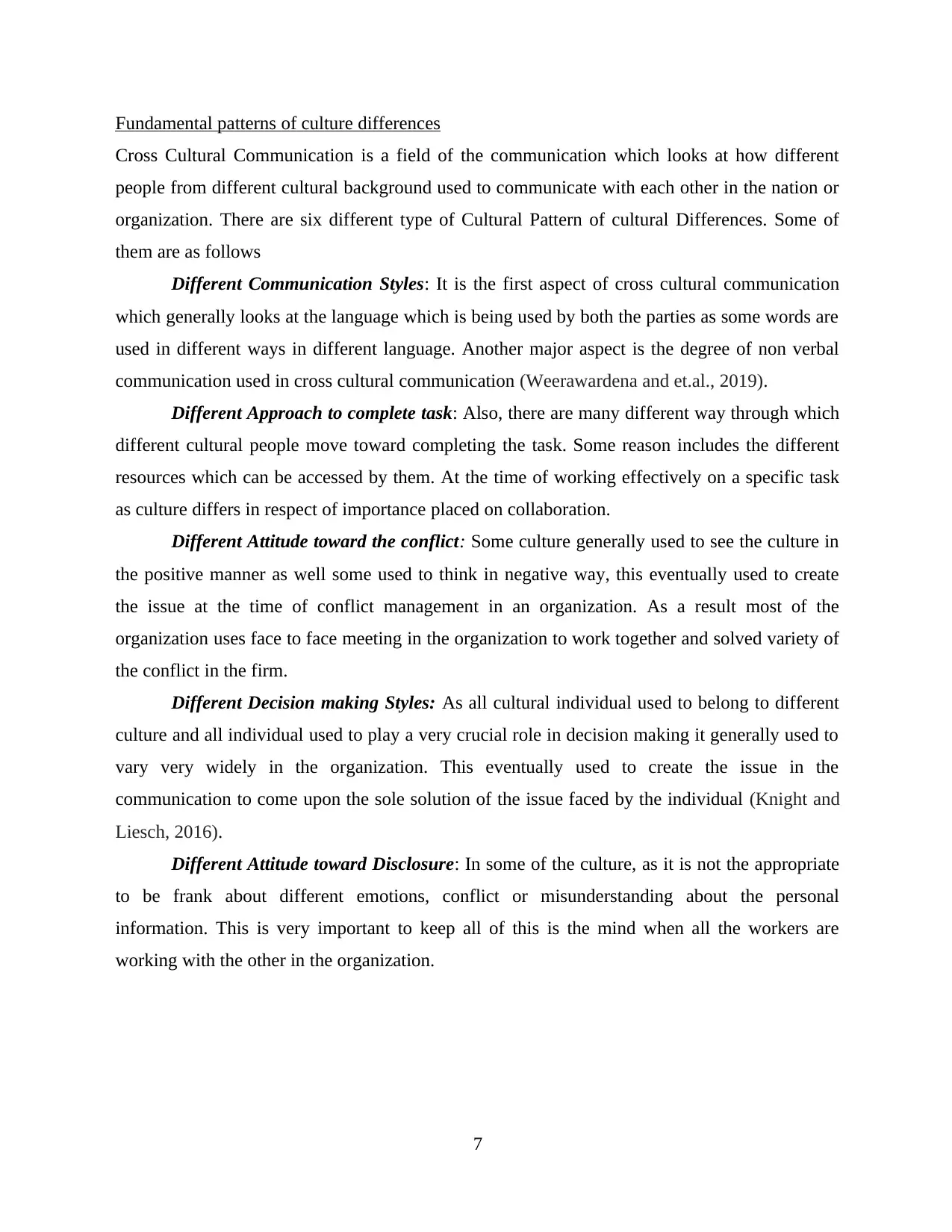
Fundamental patterns of culture differences
Cross Cultural Communication is a field of the communication which looks at how different
people from different cultural background used to communicate with each other in the nation or
organization. There are six different type of Cultural Pattern of cultural Differences. Some of
them are as follows
Different Communication Styles: It is the first aspect of cross cultural communication
which generally looks at the language which is being used by both the parties as some words are
used in different ways in different language. Another major aspect is the degree of non verbal
communication used in cross cultural communication (Weerawardena and et.al., 2019).
Different Approach to complete task: Also, there are many different way through which
different cultural people move toward completing the task. Some reason includes the different
resources which can be accessed by them. At the time of working effectively on a specific task
as culture differs in respect of importance placed on collaboration.
Different Attitude toward the conflict: Some culture generally used to see the culture in
the positive manner as well some used to think in negative way, this eventually used to create
the issue at the time of conflict management in an organization. As a result most of the
organization uses face to face meeting in the organization to work together and solved variety of
the conflict in the firm.
Different Decision making Styles: As all cultural individual used to belong to different
culture and all individual used to play a very crucial role in decision making it generally used to
vary very widely in the organization. This eventually used to create the issue in the
communication to come upon the sole solution of the issue faced by the individual (Knight and
Liesch, 2016).
Different Attitude toward Disclosure: In some of the culture, as it is not the appropriate
to be frank about different emotions, conflict or misunderstanding about the personal
information. This is very important to keep all of this is the mind when all the workers are
working with the other in the organization.
7
Cross Cultural Communication is a field of the communication which looks at how different
people from different cultural background used to communicate with each other in the nation or
organization. There are six different type of Cultural Pattern of cultural Differences. Some of
them are as follows
Different Communication Styles: It is the first aspect of cross cultural communication
which generally looks at the language which is being used by both the parties as some words are
used in different ways in different language. Another major aspect is the degree of non verbal
communication used in cross cultural communication (Weerawardena and et.al., 2019).
Different Approach to complete task: Also, there are many different way through which
different cultural people move toward completing the task. Some reason includes the different
resources which can be accessed by them. At the time of working effectively on a specific task
as culture differs in respect of importance placed on collaboration.
Different Attitude toward the conflict: Some culture generally used to see the culture in
the positive manner as well some used to think in negative way, this eventually used to create
the issue at the time of conflict management in an organization. As a result most of the
organization uses face to face meeting in the organization to work together and solved variety of
the conflict in the firm.
Different Decision making Styles: As all cultural individual used to belong to different
culture and all individual used to play a very crucial role in decision making it generally used to
vary very widely in the organization. This eventually used to create the issue in the
communication to come upon the sole solution of the issue faced by the individual (Knight and
Liesch, 2016).
Different Attitude toward Disclosure: In some of the culture, as it is not the appropriate
to be frank about different emotions, conflict or misunderstanding about the personal
information. This is very important to keep all of this is the mind when all the workers are
working with the other in the organization.
7
Paraphrase This Document
Need a fresh take? Get an instant paraphrase of this document with our AI Paraphraser
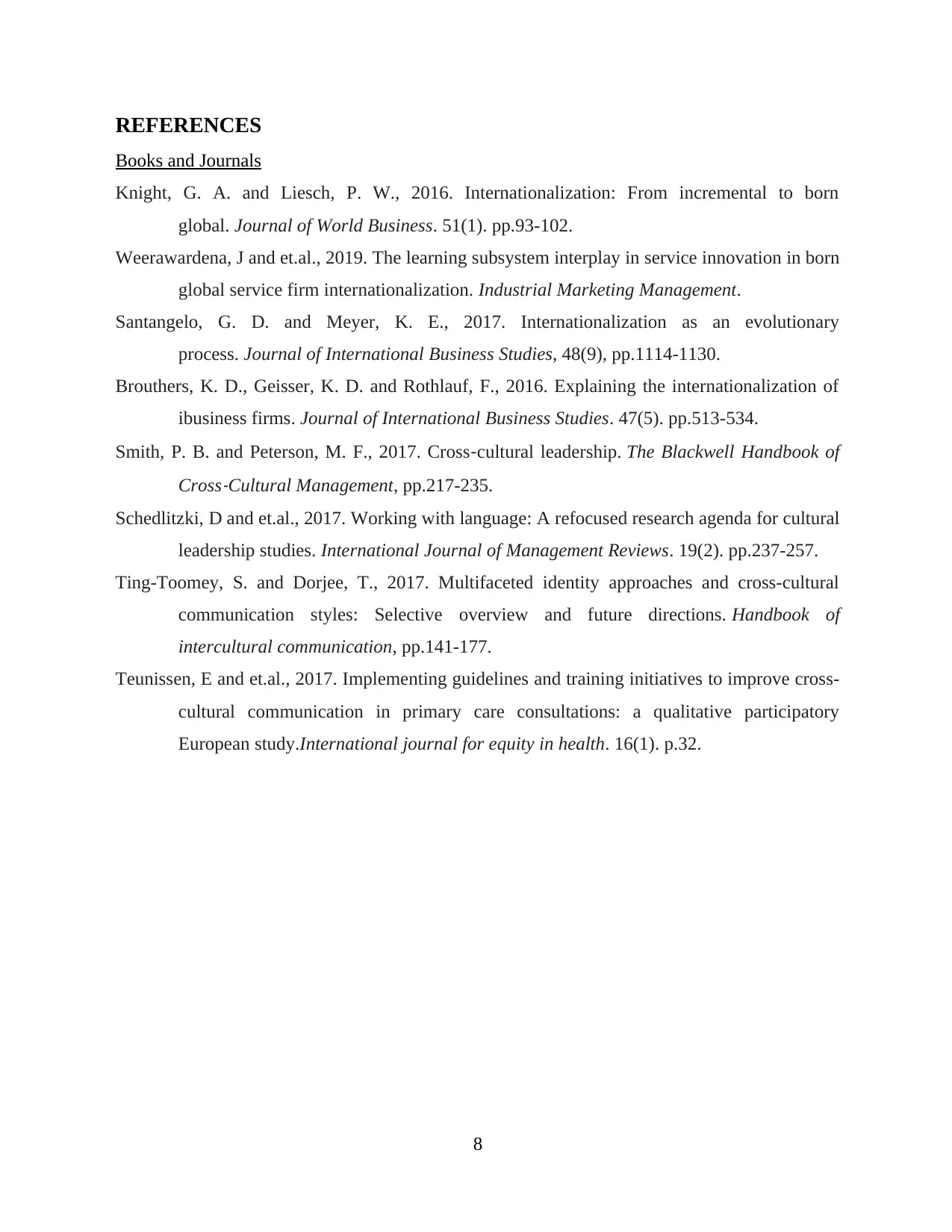
REFERENCES
Books and Journals
Knight, G. A. and Liesch, P. W., 2016. Internationalization: From incremental to born
global. Journal of World Business. 51(1). pp.93-102.
Weerawardena, J and et.al., 2019. The learning subsystem interplay in service innovation in born
global service firm internationalization. Industrial Marketing Management.
Santangelo, G. D. and Meyer, K. E., 2017. Internationalization as an evolutionary
process. Journal of International Business Studies, 48(9), pp.1114-1130.
Brouthers, K. D., Geisser, K. D. and Rothlauf, F., 2016. Explaining the internationalization of
ibusiness firms. Journal of International Business Studies. 47(5). pp.513-534.
Smith, P. B. and Peterson, M. F., 2017. Cross‐cultural leadership. The Blackwell Handbook of
Cross
‐Cultural Management, pp.217-235.
Schedlitzki, D and et.al., 2017. Working with language: A refocused research agenda for cultural
leadership studies. International Journal of Management Reviews. 19(2). pp.237-257.
Ting-Toomey, S. and Dorjee, T., 2017. Multifaceted identity approaches and cross-cultural
communication styles: Selective overview and future directions. Handbook of
intercultural communication, pp.141-177.
Teunissen, E and et.al., 2017. Implementing guidelines and training initiatives to improve cross-
cultural communication in primary care consultations: a qualitative participatory
European study.International journal for equity in health. 16(1). p.32.
8
Books and Journals
Knight, G. A. and Liesch, P. W., 2016. Internationalization: From incremental to born
global. Journal of World Business. 51(1). pp.93-102.
Weerawardena, J and et.al., 2019. The learning subsystem interplay in service innovation in born
global service firm internationalization. Industrial Marketing Management.
Santangelo, G. D. and Meyer, K. E., 2017. Internationalization as an evolutionary
process. Journal of International Business Studies, 48(9), pp.1114-1130.
Brouthers, K. D., Geisser, K. D. and Rothlauf, F., 2016. Explaining the internationalization of
ibusiness firms. Journal of International Business Studies. 47(5). pp.513-534.
Smith, P. B. and Peterson, M. F., 2017. Cross‐cultural leadership. The Blackwell Handbook of
Cross
‐Cultural Management, pp.217-235.
Schedlitzki, D and et.al., 2017. Working with language: A refocused research agenda for cultural
leadership studies. International Journal of Management Reviews. 19(2). pp.237-257.
Ting-Toomey, S. and Dorjee, T., 2017. Multifaceted identity approaches and cross-cultural
communication styles: Selective overview and future directions. Handbook of
intercultural communication, pp.141-177.
Teunissen, E and et.al., 2017. Implementing guidelines and training initiatives to improve cross-
cultural communication in primary care consultations: a qualitative participatory
European study.International journal for equity in health. 16(1). p.32.
8
1 out of 8
Related Documents
Your All-in-One AI-Powered Toolkit for Academic Success.
+13062052269
info@desklib.com
Available 24*7 on WhatsApp / Email
![[object Object]](/_next/static/media/star-bottom.7253800d.svg)
Unlock your academic potential
Copyright © 2020–2025 A2Z Services. All Rights Reserved. Developed and managed by ZUCOL.





